The Pistol Star (V4647 Sagittarii) is a blue hypergiant star located in the southern constellation Sagittarius. It is one of the most massive and luminous stars in our galaxy. The star illuminates the Pistol Nebula, from which it takes its name. Both the star and the nebula are located about 25,000 light years away in the Quintuplet Cluster, one of the most massive open clusters in the Milky Way.
Star type
The Pistol Star is a luminous blue variable (LBV), an exceptionally luminous, massive, and unstable supergiant star that undergoes periodic outbursts and occasional giant eruptions. Like other LBVs, including the more famous Eta Carinae, the Pistol Star shows a range of spectroscopic and photometric variations.
The star cannot be observed visually because its light is blocked by the dust in the region of the Galactic Centre and its visual magnitude is greater than 28. Without extinction, it would be a 4th magnitude star, visible to the unaided eye from a distance of 25,000 light years.
The Pistol Star has a mass 27.5 times that of the Sun and has expanded to a size of 435 solar radii. It is 3,300,000 times more luminous than the Sun with an effective temperature between 11,800 and 12,000 K. The star’s estimated age is about 4 million years.
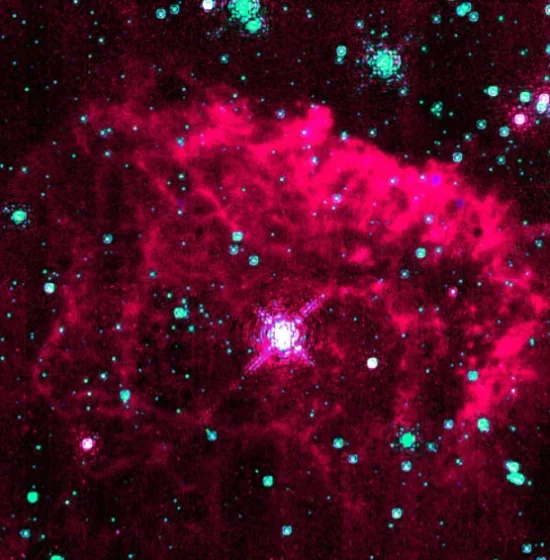
One of the intrinsically brightest stars in our galaxy appears as the bright white dot in the center of this image taken with NASA’s Hubble Space Telescope. Hubble’s Near Infrared Camera and Multi-Object Spectrometer (NICMOS) was needed to take the picture, because the star is hidden at the galactic center, behind obscuring dust. Image: Don F. Figer (UCLA) and NASA
Mass
The mass of the Pistol Star is uncertain. Estimates of its initial mass go as high as 200 solar masses, but its current mass is significantly less. Even though earlier studies estimated a mass 250 times that of the Sun, giving the star the title of the most massive star known, more recent studies give significantly lower estimates.
A 2008 study used evolutionary tracks and determined a mass between 86.5 and 92 solar masses with an initial mass of 200 solar masses.
A 2009 study suggested a mass of 27.5 solar masses with an initial mass of 100 solar masses. The estimate was based on modelling the star to match its spectrum.
The star is believed to have lost almost 10 solar masses in large outbursts between 4,000 and 6,000 years ago. It has a very strong stellar wind, more than 10 billion times stronger than the Sun’s.
Supernova
Even though the Pistol Star is still very young, its high mass determines its ultimate fate as a supernova or hypernova in 1 to 3 million years.
All luminous blue variables end their lives as supernovae. They can also undergo giant outbursts accompanied by dramatic mass loss even before they go out. These events can be mistaken for supernovae because the stars undergo remarkable increases in luminosity. Well-known examples of historical supernova impostor events have been recorded for Eta Carinae and P Cygni.
Size
With a radius 435 times that of the Sun, if it were at the centre of the solar system, the Pistol Star would extend past the orbit of Mars. While this earns it a place of the list of the largest known stars, the star is nowhere near the size of other well-known behemoths, including Antares (680 R☉), Betelgeuse (764 R☉), VX Sagittarii (1,120 – 1,550 R☉), VY Canis Majoris (1,420 or 2,069 R☉), UY Scuti (1,708 R☉) and the current record-holder Stephenson 2-18 (2,150 R☉).
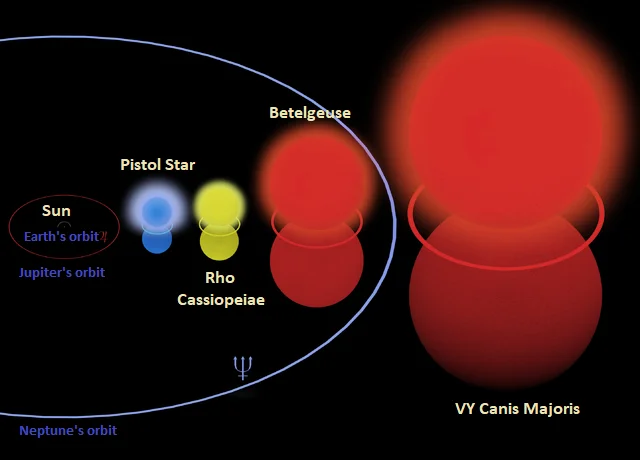
The Sun compared to Pistol Star, Rho Cassiopeiae, Betelgeuse and VY Canis Majoris, image: Wikimedia Commons/Anynobody (CC BY-SA 3.0)
Luminosity
The Pistol Star is one of the most luminous stars in our galaxy. With 3.3 million solar luminosities, it was once a record holder for the most luminous star known. However, it does not come even close to the current record holder, the Wolf-Rayet star R136a1 in the Large Magellanic Cloud, which shines with 6.166 million solar luminosities. The Pistol Star is also less luminous than Milky Way stars G0.238-0.071, a blue O-type supergiant with 5.012 million solar luminosities in the Galactic Centre, and Eta Carinae, the behemoth embedded in the Carina Nebula, a luminous blue variable 4.6 million times more luminous than the Sun.
There is some uncertainty about the Pistol Star’s luminosity. A 2005 study used modelling and analysed the metal lines in the star’s spectrum to derive a luminosity of 1.7510 million solar luminosities and an effective temperature of about 11,000 K.
Some studies have further reduced the star’s estimated luminosity to about 1.6 million solar luminosities with an estimated radius of 306 solar radii and a surface temperature of 12,000 K, while others derived a luminosity 3.3 million times that of the Sun with a radius of 435 solar radii.
Pistol Nebula
The Pistol Nebula formed within the last 10,000 years when the central star ejected a massive amount of material with a mass loss rate of about 10−3 M☉ yr−1. The material is distributed in two shells centred on the star and photoionized by nearby Wolf-Rayet stars in the Quintuplet Cluster. The shells are believed to be about 4,000 and 6,000 years old. The outer shell expands at a velocity of 60 km/s.
The Pistol Nebula has a total infrared luminosity of 520,000 solar luminosities. It has east-west and north-south dimensions of 4.57 by 3.91 light years, comparable to the distance between the Sun and Alpha Centauri.
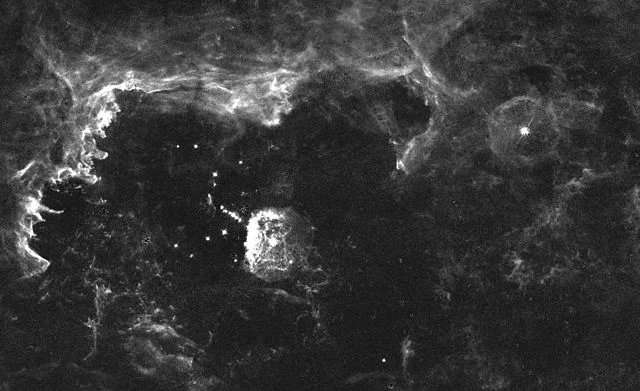
Hubble Space Telescope image of the Quintuplet Cluster region. The Pistol Star is seen in the middle, surrounded by its ejection nebula. The luminous blue variable (LBV) star G0.120−0.048 is at the upper right, surrounded by a spherical nebula, believed to have been ejected by that star. LBV qF362 to the left of the Pistol Star also seems to be surrounded by a low-level nebular emission. Image: NASA/ESA, Hubble
A 1999 study confirmed that the nebula was formed from material ejected from the Pistol Star but argued that the star itself is responsible for less than 8% of the total ionizing flux to the nebula. The study proposed that the nebula was primarily ionized by the nearby hot, luminous stars of the Quintuplet Cluster and that it was interacting with these stars’ strong stellar winds. The study identified two exceptionally hot stars (> 50,000 K) north of the Pistol Star that ionize a part of the nebula, while their stellar winds decelerate the nebula’s expanding gas. The same study suggested that the Pistol Nebula was the most massive nebula formed of ejected material of a luminous blue variable, with about 10 solar masses of gas.
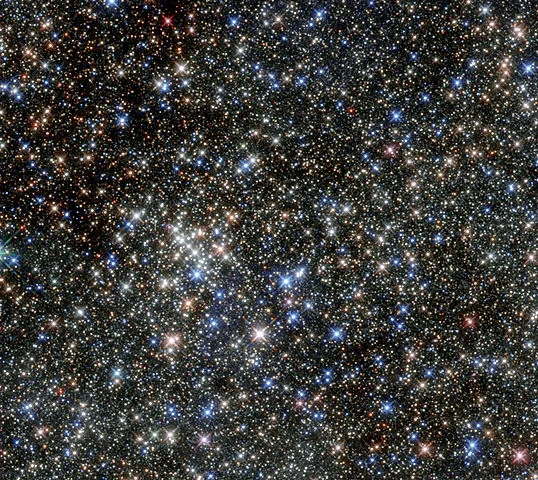
Although this cluster of stars gained its name due to its five brightest stars, it is home to hundreds more. The huge number of massive young stars in the cluster is clearly captured in this NASA/ESA Hubble Space Telescope image. The cluster is located close to the Arches Cluster and is just 100 light-years from the centre of our galaxy. The cluster’s proximity to the dust at the centre of the galaxy means that much of its visible light is blocked, which helped to keep the cluster unknown until its discovery in 1990, when it was revealed by observations in the infrared. Infrared images of the cluster, like the one shown here, allow us to see through the obscuring dust to the hot stars in the cluster. The Quintuplet Cluster hosts two very rare luminous blue variable stars: the Pistol Star and the lesser known V4650 Sgr. If you were to draw a line horizontally through the centre of this image from left to right, you could see the Pistol Star hovering just above the line about one third of the way along it. Image: ESA/Hubble & NASA
Quintuplet Cluster
The Quintuplet Cluster is a dense young open cluster located about 26,000 light years away in the direction of the Milky Way centre. It is only 100 light years away from the Galactic Centre and believed to be physically associated with it. It is one of three massive clusters in the region of the Galactic Centre. The other two are the denser and larger Arches Cluster and the GC star cluster, located near the Milky Way’s supermassive black hole.
The Quintuplet Cluster is home to at least two luminous blue variables, 21 Wolf-Rayet stars (more than any other cluster), and a number of red supergiants, whose presence indicates that the cluster is a bit more evolved. The estimated age of the cluster is about 4 million years.
Like the Pistol Star, the cluster is heavily obscured by dust and cannot be seen visually. It can only be observed in the infrared, X-ray, and radio bands.
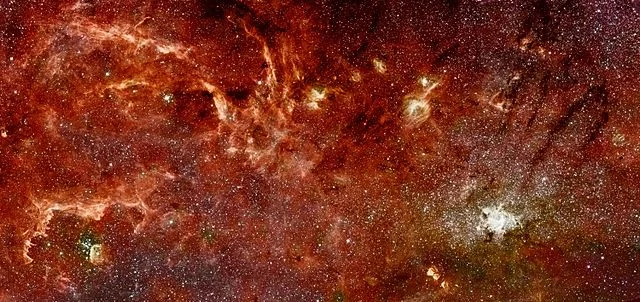
This composite colour infra-red image of the centre of our Milky Way galaxy reveals a new population of massive stars and new details in complex structures in the hot ionized gas swirling around the central 300 light-years. This sweeping panorama is the sharpest infra-red picture ever made of the Galactic core and offers a laboratory for how massive stars form and influence their environment in the nuclear regions of other galaxies. This view combines the sharp imaging of the Hubble Space Telescope’s Near Infrared Camera and Multi-Object Spectrometer (NICMOS) with colour imagery from a previous Spitzer Space Telescope survey done with its Infra-red Astronomy Camera (IRAC). The Galactic core is obscured in visible light by intervening dust clouds, but infra-red light penetrates the dust. NICMOS shows a large number of these massive stars distributed throughout the region. A new finding is that astronomers now see that the massive stars are not confined to one of the three known clusters of massive stars in the Galactic Centre, known as the Central cluster, the Arches cluster, and the Quintuplet cluster. These three clusters are easily seen as tight concentrations of bright, massive stars in the NICMOS image. The distributed stars may have formed in isolation, or they may have originated in clusters that have been disrupted by strong gravitational tidal forces. The winds and radiation from these stars form the complex structures seen in the core, and in some cases, they may be triggering new generations of stars. Image: Hubble: NASA, ESA, and Q.D. Wang (University of Massachusetts, Amherst); Spitzer: NASA, Jet Propulsion Laboratory, and S. Stolovy (Spitzer Science Center/Caltech)
The cluster was first detected in 1983 when observations in the infrared revealed two sources near the Galactic Centre. One of these sources was later resolved into four sources. The five sources formed a compact quintuplet, giving the cluster its name.
The Pistol Star is one of three luminous blue variables in and near the Quintuplet Cluster. The other two stars have the designations G0.120-0.048 (V4998 Sagittarii), and qF362 (V4650 Sagittarii). The three stars have similar luminosities and wind velocities of about 100 km/s. V4650 Sgr is a member of the cluster and lies at the cluster’s edge, while V4998 Sgr is positioned about 23 light years away.
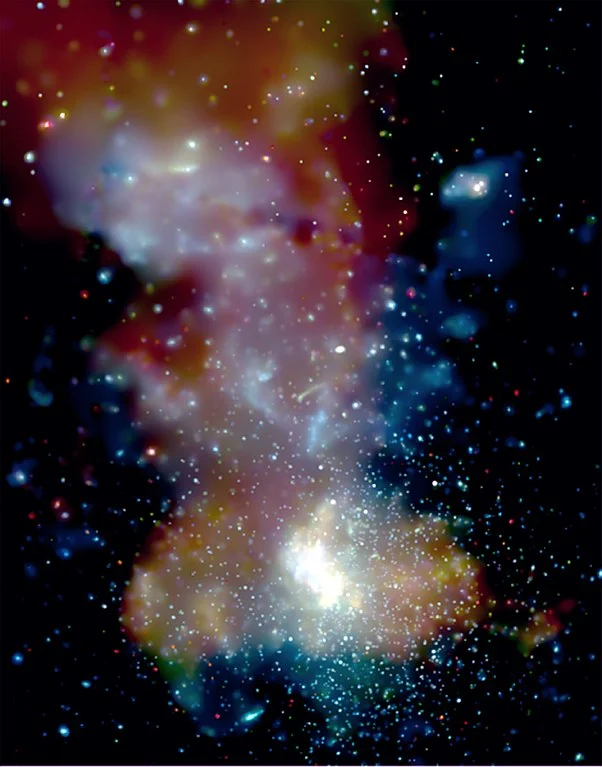
The clusters, Arches (upper right), Quintuplet (upper center), and the GC cluster (bottom center), contain massive stars that appear as very bright, point-like X-ray sources when winds from their surfaces collide with those from an orbiting companion. Vast amounts of energy are also released when these stars go out as supernovas, heating the surrounding material. Stellar corpses in this image also emit X-rays as either neutron stars or black holes in binary systems. Collisions between the clusters themselves and cooler molecular clouds of gas contribute to the diffuse X-rays seen in this image. Image: Chandra X-ray Observatory, NASA/CXC/UMass Amherst/Q.D.Wang et al.
Facts
The Pistol Star was discovered by the American astronomer Don Figer and his team, who performed the first census of massive stars in the Quintuplet Cluster and its Sagittarius neighbour the Arches Cluster using the Hubble Space Telescope in the 1990s. They identified the Pistol Star as one of the most massive stars known in the Milky Way.
In 1998, Figer and his team published a study that demonstrated that the Pistol Star is one of the most luminous stars known. The study used evolutionary tracks to determine an initial mass between 200 and 250 solar masses for the star and gave an estimated age between 1.7 and 2.1 million years. It suggested that the Pistol Star was a luminous blue variable that had recently ejected a large among of material. Furthermore, it concluded that the Pistol Nebula was photoionized circumstellar ejecta, material lost from the star during eruptive episodes of mass loss. The line-of-sight velocity of the star matches the average velocity of the gas in the nebula.
Name
The Pistol Star does not have a formal name. It is known by the designations V4647 Sagittarii (V4647 Sgr) and qF 134. It was nicknamed the Pistol Star after the nebula that surrounds it. The Pistol Nebula, in turn, was named for its shape, which resembled that of a pistol in low-resolution images taken in the 1980s.
Location
The Pistol Star lies in the direction of the Galactic Centre (Sagittarius A*), west of the Teapot asterism that dominates the constellation Sagittarius. It is located just south of the white bright giant 3 Sagittarii (mag. 4.54). However, the star cannot be seen even in the largest of telescopes.
In the infrared band, the Quintuplet Cluster can be seen 12 arcminutes northwest of Sagittarius A*, the bright radio source that marks the location of Milky Way’s central supermassive black hole.
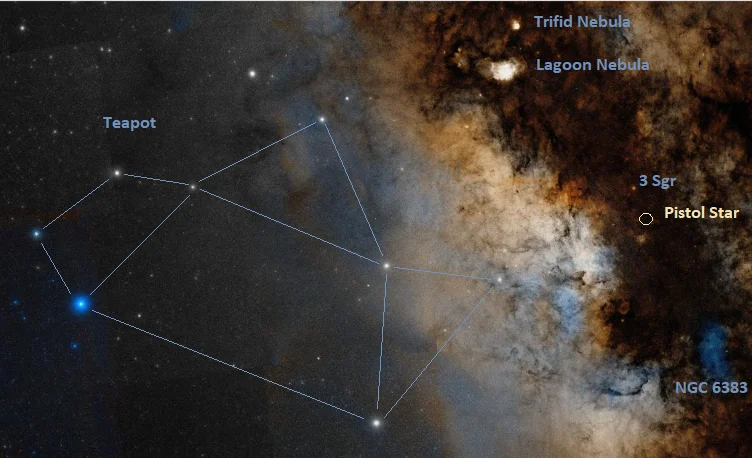
The location of the Pistol Star in Sagittarius, image: Wikisky
Constellation
Pistol Star is located in the constellation Sagittarius. Representing the Archer, Sagittarius is one of the larger southern constellations and the 15th largest of all constellations with an area of 867 square degrees. Like all zodiac constellations, it was first catalogued by Claudius Ptolemy in his Almagest in the 2nd century CE and is considered one of the 48 Greek constellations.
Sagittarius is best known for the Teapot asterism, formed by its brightest stars, the radio source Sagittarius A*, marking the centre of the Milky Way, and for the bright emission nebulae Messier 8 (the Lagoon Nebula) and Messier 17 (the Omega or Swan Nebula).
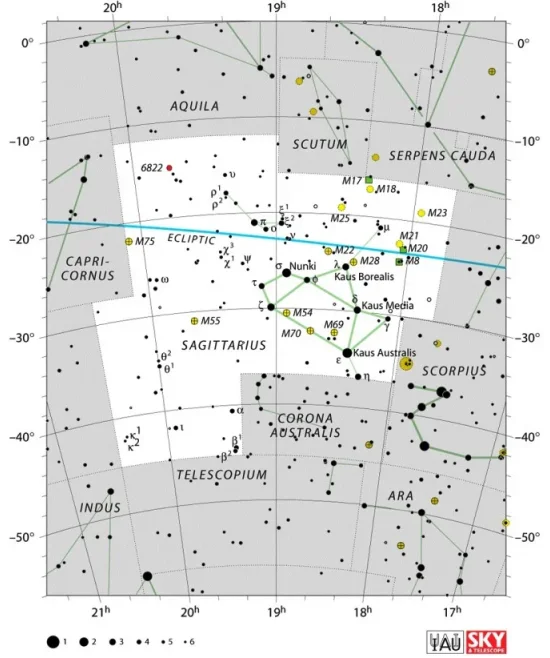
Sagittarius constellation map by IAU and Sky&Telescope magazine
The constellation is home to more Messier objects (bright deep sky objects catalogued by the French astronomer Charles Messier) than any other constellation. In addition to M8 and M17, these include the emission, reflection and dark nebula known as the Trifid Nebula (Messier 20), the Small Sagittarius Star Cloud (a Milky Way star cloud catalogued as Messier 24), the open clusters Messier 23 and Messier 25, and the globular clusters Messier 22, Messier 28, Messier 54, Messier 55, Messier 69, and Messier 75.
Sagittarius also contains the Sagittarius Dwarf Elliptical Galaxy (Sag DEG), a satellite of the Milky Way, the globular cluster NGC 6723 (the Chandelier Cluster), the star-forming Chinese Dragon Nebula (NGC 6559) and the planetary nebulae known as the Red Spider Nebula (NGC 6537), the Eye of Sauron Nebula (M 1-42), the Little Gem Nebula (NGC 6818) and the Box Nebula (NGC 6445).
Notable stars in Sagittarius include the constellation’s luminary Kaus Australis (Epsilon Sagittarii), a blue-white giant in a binary system, the orange giants Kaus Media (Delta Sagittarii), Kaus Borealis (Lambda Sagittarii), Tau Sagittarii and Alnasl (Gamma2 Sagittarii), the red giant Eta Sagittarii, the Wolf-Rayet star WR 102ka (the Peony Star), one of the most luminous star in our galaxy, the red supergiants KW Sagittarii and VX Sagittarii, both among the largest stars known, and Sakurai’s Object (V4334 Sagittarii), a born-again star believed to have become a red giant again after a short period of being a white dwarf.
The best time of year to observe the stars and deep sky objects of Sagittarius is during the month of August. The entire constellation is visible from locations between the latitudes 55° N and 90° S.
The 10 brightest stars in Sagittarius are Kaus Australis (Epsilon Sgr, mag. 1.85), Nunki (Sigma Sgr, mag. 2.05), Ascella (Zeta Sgr, mag. 2.59), Kaus Media (Delta Sgr, mag. 2.70), Kaus Borealis (Lambda Sgr, mag. 2.82), Albaldah (Pi Sgr, mag. 2.89), Alnasl (Gamma² Sgr, mag. 2.98), Eta Sagittarii (mag. 3.11), Phi Sagittarii (mag. 3.17), and Tau Sagittarii (mag. 3.326).
Pistol Star – V4647 Sagittarii
| Spectral class | LBV |
| Variable type | LBV |
| Apparent magnitude | >28 |
| Apparent magnitude (J) | 11.828 |
| Apparent magnitude (H) | 8.920 |
| Apparent magnitude (K) | 7.291 |
| Distance | 25,000 light years (7,700 parsecs) |
| Radial velocity | +130 km/s |
| Mass | 27.5 M☉ |
| Luminosity | 3,300,000 L☉ |
| Radius | 435 R☉ |
| Temperature | 11,800 – 12,000 K |
| Metallicity | 0.1 dex |
| Age | 4 million years |
| Constellation | Sagittarius |
| Right ascension | 17h 46m 15.240s |
| Declination | −28° 50′ 03.58’’ |
| Names and designations | Pistol Star, V4647 Sagittarii, V4647 Sgr, qF 134, 2MASS J17461524-2850035, TIC 322752144 |